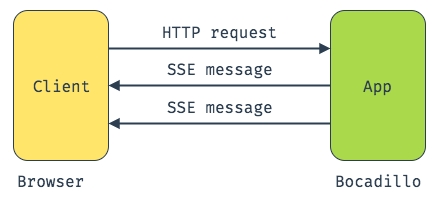Warning: Bocadillo is now UNMAINTAINED. Users are recommended to migrate to a supported alternative, such as Starlette or FastAPI. Please see #344 for more information.
Server-Sent Events
Bocadillo has built-in support for Server-Sent Events (a.k.a SSE), a technique that allows servers to push real-time updates to clients. For example, a notification system or a live feed can easily be implemented using SSE.
Please note that SSE is unidirectional: only the server can send messages, not the client. Besides, browser support is limited. If you need bi-directional asynchronous communication between the server and the client, take a look at WebSockets.
SSE basics
An SSE endpoint sends messages (known as server events) over a single, long-lived connection in order to notify the client that data has changed or that new data is available.

Under the hood, this is very similar to response streaming, except that:
- Messages must be encoded in a specific format known as the event stream format.
- Specific HTTP headers must be set so that the connection is kept alive, and that the client (typically a JavaScript program written using the EventSource API) correctly decodes messages.
Luckily, Bocadillo helps you with all of these tasks.
Example
The following example exposes an SSE endpoint that simulates a feed of temperature data:
from asyncio import sleep
import random
from bocadillo import App, server_event
app = App()
@app.route("/temperature-feed")
async def temperature_feed(req, res):
@res.event_stream
async def send_temperature_data():
while True:
temperature = await get_temperature()
yield server_event(json={"temperature": temperature})
await sleep(0.01)
async def get_temperature():
# TODO: get this from a sensor or something?
return 10 + 2 * (2 * random.random() - 1)
Let's break this code down:
- We import useful functions and classes, including the
server_eventhelper (more on that shortly). - We create an application instance and a
/temperature-feedroute. - Inside the view, we define an event stream using the
@res.event_streamdecorator. - The event stream is an asynchronous generator that
yields SSE messages indefinitely. In this case, messages are JSON-encoded.
Messages
The Event Stream specification describes the fields that an SSE message can contain.
In theory, you could write the messages by hand and yield them in the @res.event_stream generator, but this would be tedious. Instead, use the server_event helper to make sure you produce spec-compliant messages.
For example, here's how the temperature event looks like:
>>> from bocadillo import server_event
>>> server_event(json={"temperature": 10.5})
'data: {"temperature": 10.5}\n\n'
As you can see, the JSON message has been serialized (encoded) and set as the data field for the message. It is followed by two empty lines, as required by the SSE specification.
Sending data
Using the server_event helper, data can be sent either:
- In plain text using the
dataparameter:
server_event(data="Hello, SSE!")
Pass an iterable for multi-line data:
server_event(data=["Hello, SSE!", "Nice to meet you."])
- As JSON using the
jsonparameter:
server_event(json={"message": "Hello, SSE!"})
Note: the SSE specification does not allow to send binary data.
Naming events
As per the SSE spec, you can give a name to a server event to allow clients to distinguish between them. Here's an example:
server_event("greeting", data="Hello, SSE!")
Client disconnects
Event streams being just streams with some extra formatting, Bocadillo handles client disconnections just like in HTTP response streaming:
- By default, client disconnections stop the event stream.
- To perform extra cleanup, pass
raise_on_disconnect=Trueand handle theClientDisconnectexception. You should make sure that no other messages are sent in the future.
Here's an example of performing extra cleanup when the client disconnects:
from bocadillo import App, ClientDisconnect
app = App()
@app.route("/temperature-feed")
async def temperature_feed(req, res):
@res.event_stream(raise_on_disconnect=True)
async def send_temperature_data():
try:
while True:
temperature = await get_temperature()
yield server_event(json={"temperature": temperature})
await sleep(0.01)
except ClientDisconnect:
print("Releasing sensor resources…")